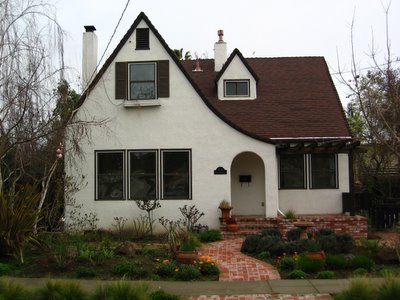Musings on garden and landscape design, gardening, urban planning, man, nature, human nature, and basically life as we know it.
Feb 25, 2006
Postscript: Curb Appeal
The Palo Alto home profiled in my Curb Appeal post has sold... for 10% over the list price. Did the landscaping have anything to do with it?
Feb 23, 2006
Hurry! Go Discover Landscape Architecture!
"The American Society of Landscape Architects (ASLA) has proclaimed April 2006 as National Landscape Architecture Month. ASLA chapters across the country will celebrate with public outreach activities to help communities 'Discover Landscape Architecture,' the theme for this year. The month encompasses Earth Day on April 22 and the birthday of Frederick Law Olmsted on April 26, who founded the American landscape architecture profession."
Wow, someone must have stayed up really late figuring out that theme.
"What are you gonna do this weekend, honey?"
"I don't know, I thought maybe I'd go discover Landscape Architecture."
"Oh, I think the Parkers down the street just went and got some of that."
"Really? I never would have figured them for the type."
"Well, don't you go getting any crazy ideas. Remember what happened when you tried to discover Black History…"
(Laughter.)
Feb 13, 2006
Problem Child
So I'm not the only one who thinks turfgrass is a problem child.
"Speakers at the 'How Native Landscaping is Healthier for People, the Environment and our Pocketbooks' forum urged suburbanites to cast away their lawn mowers and fertilizers and embrace a new life with native vegetation.
“'Turf has an incredibly vicious cycle of need,' said landscape architect Jay Womack of Wight and Co., a firm that specializes in environmental work. 'It’s a vicious, vicious cycle of maintenance.'”
 The forum apparently recommended buffalo grass as a native substitute for the most common turfgrass, Kentucky bluegrass, noting that buffalo grass requires less water and more maintenance. (On the other hand, buffalo grass also goes dormant in the winter months and is less than ideal for high-traffic areas and shady sites.)
The forum apparently recommended buffalo grass as a native substitute for the most common turfgrass, Kentucky bluegrass, noting that buffalo grass requires less water and more maintenance. (On the other hand, buffalo grass also goes dormant in the winter months and is less than ideal for high-traffic areas and shady sites.)
All in all, I think it's great that people are beginning to talk en masse about replacing greedy turfgrasses with more appropriate plantings.
I'm just not sure that calling bluegrass "Eurotrash" really shames it.
"Speakers at the 'How Native Landscaping is Healthier for People, the Environment and our Pocketbooks' forum urged suburbanites to cast away their lawn mowers and fertilizers and embrace a new life with native vegetation.
“'Turf has an incredibly vicious cycle of need,' said landscape architect Jay Womack of Wight and Co., a firm that specializes in environmental work. 'It’s a vicious, vicious cycle of maintenance.'”
All in all, I think it's great that people are beginning to talk en masse about replacing greedy turfgrasses with more appropriate plantings.
I'm just not sure that calling bluegrass "Eurotrash" really shames it.
Feb 10, 2006
Curb Appeal
How do you make a house look great in preparation for offering it for sale? One of the most important factors is that hard-to-define quality of "curb appeal." The changes don't need to be huge; just some judicious color and some handsome accents can change the potential buyer's first impression from "ho-hum" to "gotta have it!"
Here's an example of some subtle changes that add up to a great effect for this English cottage style garden:
The best part is, these changes don't need to be expensive. The transformation above cost about $1000 in plants, mulch and labor; the sellers of this home at 2255 Cornell Street estimate it added about 5x that amount to the home's desirability.
Here's an example of some subtle changes that add up to a great effect for this English cottage style garden:
 before… before… | |
…and after | |
with the addition of some  color color | |
and a little  style. style. |
The best part is, these changes don't need to be expensive. The transformation above cost about $1000 in plants, mulch and labor; the sellers of this home at 2255 Cornell Street estimate it added about 5x that amount to the home's desirability.
Subscribe to:
Comments (Atom)